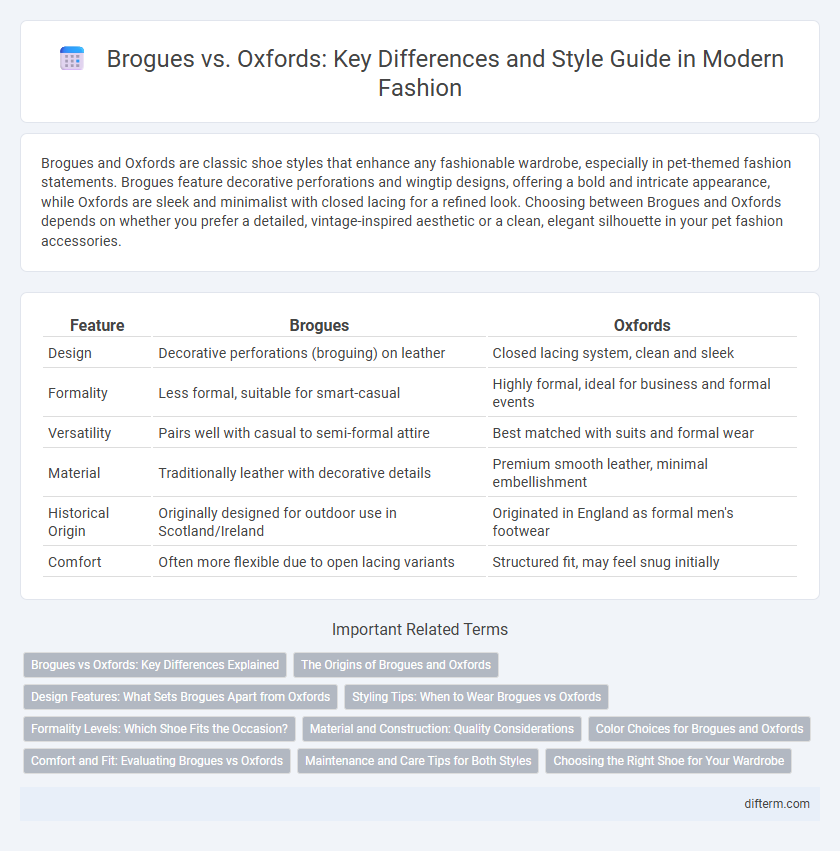Brogues and Oxfords are classic shoe styles that enhance any fashionable wardrobe, especially in pet-themed fashion statements. Brogues feature decorative perforations and wingtip designs, offering a bold and intricate appearance, while Oxfords are sleek and minimalist with closed lacing for a refined look. Choosing between Brogues and Oxfords depends on whether you prefer a detailed, vintage-inspired aesthetic or a clean, elegant silhouette in your pet fashion accessories.
Table of Comparison
| Feature | Brogues | Oxfords |
|---|---|---|
| Design | Decorative perforations (broguing) on leather | Closed lacing system, clean and sleek |
| Formality | Less formal, suitable for smart-casual | Highly formal, ideal for business and formal events |
| Versatility | Pairs well with casual to semi-formal attire | Best matched with suits and formal wear |
| Material | Traditionally leather with decorative details | Premium smooth leather, minimal embellishment |
| Historical Origin | Originally designed for outdoor use in Scotland/Ireland | Originated in England as formal men's footwear |
| Comfort | Often more flexible due to open lacing variants | Structured fit, may feel snug initially |
Brogues vs Oxfords: Key Differences Explained
Brogues are characterized by decorative perforations and serrated edges on the leather, offering a more casual and textured appearance compared to the sleek, plain design of Oxfords. Oxfords feature a closed lacing system, which provides a clean and formal silhouette ideal for business and formal occasions, while Brogues often have an open lacing system, contributing to their relaxed style. The key difference lies in the detailing and formality, with Brogues suited for smart-casual ensembles and Oxfords preferred for traditional, polished looks.
The Origins of Brogues and Oxfords
Brogues originated in Ireland and Scotland as rugged outdoor footwear characterized by perforated patterns designed to allow water drainage. Oxfords trace back to 19th-century England, gaining prominence as a formal, closed-lacing shoe favored in academic and professional settings. Both styles have evolved from functional origins to iconic staples in men's fashion, each distinct in design and cultural heritage.
Design Features: What Sets Brogues Apart from Oxfords
Brogues are distinguished by their decorative perforations and serrated edges, adding intricate detailing and a rugged aesthetic to the shoes. Oxfords feature a sleek, closed-lacing system with minimal embellishment, emphasizing a clean and formal silhouette. The presence of broguing not only enhances the visual complexity of brogues but also signifies their traditional association with casual and semi-formal wear compared to the streamlined elegance of Oxfords.
Styling Tips: When to Wear Brogues vs Oxfords
Brogues are ideal for casual to smart-casual outfits, complementing jeans, chinos, and casual suits with their decorative perforations that add a touch of personality. Oxfords are best suited for formal occasions, business meetings, and weddings, offering a sleek, minimalist design that pairs perfectly with tailored suits and dress trousers. For versatile style, brogues bring character to daytime events, while Oxfords provide refined elegance for evening or professional settings.
Formality Levels: Which Shoe Fits the Occasion?
Brogues feature decorative perforations and a more textured design, making them ideal for smart-casual and semi-formal occasions, while Oxfords offer a sleek, minimalist silhouette suited for highly formal events like weddings and business meetings. The closed lacing system of Oxfords provides a polished appearance that complements suits and tuxedos, whereas brogues pair well with chinos and blazers for a refined yet relaxed look. Choosing between brogues and Oxfords depends on the event's dress code, with Oxfords excelling in formality and brogues balancing style with versatility.
Material and Construction: Quality Considerations
Brogues typically feature perforated leather with decorative patterns, crafted from full-grain or top-grain leather for durability and breathability, making them ideal for casual to semi-formal wear. Oxfords are usually constructed with smooth, tightly grained calfskin or patent leather, emphasizing sleekness and formality through closed lacing and minimal stitching. Both shoes require precise stitching and high-quality leather to ensure longevity and comfort, with brogues often incorporating Goodyear welt construction, while Oxfords favor Blake stitching for a slimmer profile.
Color Choices for Brogues and Oxfords
Brogues often showcase a wider range of color choices, including classic brown, tan, and oxblood, which highlight their perforated detailing and casual versatility. Oxfords typically come in more traditional colors such as black, dark brown, and navy, emphasizing their sleek, formal appearance. Selecting the right color can enhance the shoe's intended use, with brogues favoring earthy and warm tones for semi-formal to casual settings, while oxfords lean towards darker, polished hues for formal occasions.
Comfort and Fit: Evaluating Brogues vs Oxfords
Brogues offer a more relaxed fit with perforated detailing that allows for better breathability, making them ideal for extended wear and varied weather conditions. Oxfords provide a snugger fit due to their closed lacing system, delivering sleekness but potentially less comfort over long periods. Choosing between Brogues and Oxfords depends on balancing style preference with comfort needs, especially for all-day use.
Maintenance and Care Tips for Both Styles
Brogues require regular cleaning to maintain their decorative perforations, using a soft brush to remove dirt and applying quality leather conditioner to prevent drying. Oxfords benefit from frequent polishing to preserve their sleek appearance and involve careful brushing to keep the leather smooth and free from scuffs. Both styles should be stored in breathable shoe bags and rotated regularly to extend their lifespan and maintain optimal shape.
Choosing the Right Shoe for Your Wardrobe
Brogues feature decorative perforations and a more casual design, making them ideal for smart-casual and semi-formal outfits, while Oxfords offer a sleek, minimalist look perfect for formal occasions and business attire. Choosing the right shoe depends on your wardrobe's primary needs--opt for brogues to add texture and personality or oxfords for a timeless, polished appearance. Consider color, material, and versatility to ensure the shoe complements your existing clothing and elevates your overall style.
Brogues vs Oxfords Infographic

 difterm.com
difterm.com